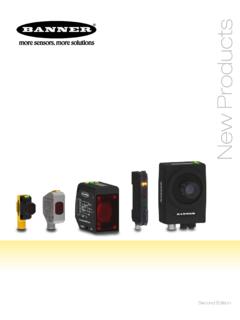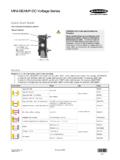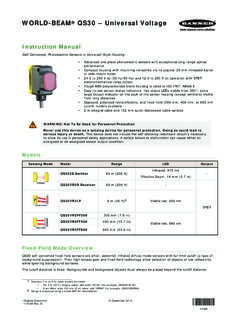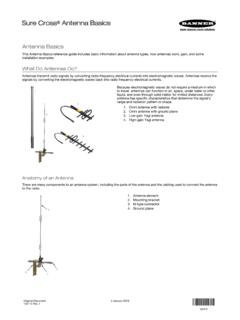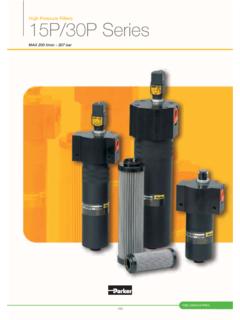Transcription of L-GAGE LT3 Long-Range Time-of-Flight Laser …
1 DatasheetSelf-Contained Class 2 Laser Distance Sensor with Analog and Discrete Outputs Extremely long range: 5 m with white targets or 3 m with gray targets Banner s unique scalable analog output automatically distributes the output signalover the width of the programmed sensing window Analog and discrete (switched) outputs in each sensor, with independent windowlimits1 Discrete output can be used for precise background suppression Choose NPN or PNP discrete output, plus 0 to 10 V dc or 4 to 20 mA sourcing analogoutput Fast, easy-to-use integrated push button TEACH-mode programming; nopotentiometer adjustments Remote TEACH-function for security and convenience Output response is programmable for three speeds Choose 2 m or 9 m unterminated cable, or 8-pin Euro-style swivel quick-disconnectconnector Rugged construction withstands demanding sensing environments; IEC IP67, NEMA6 WARNING: Not To Be Used for Personnel ProtectionNever use this device as a sensing device for personnel protection.
2 Doing so could lead to serious injury or device does not include the self-checking redundant circuitry necessary to allow its use in personnel safetyapplications. A sensor failure or malfunction can cause either an energized or de-energized sensor : Do Not Disassemble for RepairThis device contains no user-serviceable components. Do not attempt to disassemble for repair. Use of controls oradjustments or performance of procedures other than those specified herein may result in hazardous radiationexposure. A defective unit must be returned to the DistanceCable 2 Discrete OutputAnalog OutputLT3PU300 mm to 5 m ( in to ) with a 90% reflectivity whitecard2 m ( ft) 8-wirePNP (Sourcing)Analog Voltage (0 V dc to 10 Vdc)LT3 PUQ8-pin Euro-style QDLT3NU2 m ( ft) 8-wireNPN (Sinking)LT3 NUQ8-pin Euro-style QDLT3PI2 m ( ft) 8-wirePNP (Sourcing)Analog Current (4 mA to 20mA)LT3 PIQ8-pin Euro-style QDLT3NI2 m ( ft) 8-wireNPN (Sinking)LT3 NIQ8-pin Euro-style QDTheory of OperationA short electrical pulse drives a semiconductor Laser diode to emit a pulse of light.
3 The emitted light is collimated through a lens, whichproduces a very narrow Laser beam. The Laser beam bounces off the target, scattering some of its light through the sensor s receivinglens to a photodiode, which creates an electrical pulse. The time interval between the two electrical pulses (transmitting and receivingthe beam) is used to calculate the distance to the target, using the speed of light as a Banner website for information on diffuse and dual-discrete models at order the 9 m cable models, add the suffix W/30 to the model number of a cabled sensor. For example, LT3PU W/30. A model with a QD-connector requires amating LT3 Long-Range Time-of-Flight Laser Sensor Original Document65742 Rev. G7 November 201765742 Multiple pulses are evaluated by the sensor s microprocessor, which calculates the appropriate output value. The analog outputprovides a variable signal (4 mA to 20 mA or 0 V dc to 10 V dc, depending on model) that is proportional to the target s position withinthe user-programmed analog window limits.
4 The discrete (switched) output energizes whenever the target is located between the user-programmed discrete window limits. Window limits for the analog and discrete outputs may be the same, or they may be 1. Theory of OperationClass 2 Laser Safety NotesRADIANT POWER mW650 - 670 nmCOMPLIES WITH 21 CFR AND EN60825-1:1994DO NOT STARE INTO BEAMCLASS 2 Laser PRODUCTLASER LIGHTA void exposure - Laser light emittedfrom this apertureLow-power lasers are, by definition, incapable of causing eye injury within the duration of ablink (aversion response) of seconds. They also must emit only visible wavelengths (400to 700 nm). Therefore, an ocular hazard may exist only if individuals overcome their naturalaversion to bright light and stare directly into the Laser lasers are required to have a hazard label and to have an indicator light to indicatethat Laser emission is operating a Class 2 Laser : Do not stare at the Laser .
5 Do not point the Laser at a person s eye. Mount open Laser beam paths either above or below eye level, where practical. Terminate the beam emitted by the Laser product at the end of its useful InstructionsSensor Power-Up and Laser -EnablePower up the sensor for 30 minutes to allow the sensor s internal temperature to stabilize before operating or attempting to programthe sensor. If the sensor is used in applications where the temperature is several degrees higher or lower than the ambienttemperature, allow the sensor to stabilize in that condition before programming the window limits. The range decreases when thesensor warms Laser -Enable feature allows the sensor to be continually powered and enabled only when being used. This eliminates the need forthe extended warm-up period between sensor s red Signal LED indicates the condition of the received signal from the object being measured. When programming thewindow limits, this LED must be on (not flashing) for the sensor to accept the setting.
6 To ensure the received signal will not be marginalduring operation, move the target object 300 mm beyond the furthest desired switch point during setup and verify the signal LED is stillon. L-GAGE LT3 Long-Range Time-of-Flight Laser - Tel: +1-763-544-3164P/N 65742 Rev. GIndicatorsADOUTPUTSIGNALFASTMEDSLOWTEAC HPOWERSPEEDO utput LEDA nalog Teach LEDP ower ON/OFF LEDS ignal LEDR esponse SpeedIndicatorsAnalog OutputProgramming Push ButtonResponse SpeedPush ButtonDiscrete Teach LEDD iscrete (switched)Output ProgrammingPush ButtonPower ON/OFF LED (green) Indicates the operating status of the ON/OFF LED StatusIndicatesOffPower is offFlashing at 2 HzDiscrete output is overloaded (Run mode)Flashing at 1 HzPower is on; Laser is disabledOnPower is on; the sensor is operating normally and the Laser is enabledPower-Up/ Laser -Enable Indicators When powering up the sensor all LEDs turn on for one second. Allow a delay for Response SpeedLaser-Enable TimeLaser-Disable TimeSlow150 ms50 msMedium60 msFast51 msOutput LED (amber) Lights when a target is sensed within the programmed discrete Speed (amber) Indicates the response speed LED (red) Indicates the strength and condition of the sensor s incoming LED StatusIndicatesOnGood signalOffNo signal is received or the target is beyond the range limitations of the sensor (with some tolerance beyond therecommended minimum and maximum sensing distance)FlashingMarginal signal strength (cannot teach limits)Response SpeedBefore setting window limits, use the sensor s speed button to toggle between the three response speed settings.
7 The selected speedwill be indicated by one of the three response speed indicator Output Response SpeedAnalog Output Frequency Response (-3dB)Slow100 ms ON and Hz (100 ms average/4 ms update rate)Medium10 ms ON and OFF45 Hz (10 ms average/2 ms update rate)Fast1 ms ON and OFF450 Hz (1 ms average/1 ms update rate)ProgrammingRemote Programming To program the sensor remotely or to disable the keypad, use the Remote Programming function. Disabling thekeypad prevents accidental or unauthorized adjustment of the programming settings. Connect the yellow wire of the sensor to +5 V dcto 24 V dc, with a remote programming switch connected between LT3 Long-Range Time-of-Flight Laser Sensor P/N 65742 Rev. - Tel: +1-763-544-31643 Note: The impedance of the remote teach input is 55 k .Programming is accomplished by following the sequence of input pulses. The duration of each pulse (corresponding to a push button click ) and the period between multiple pulses are defined as T : seconds T Output Slope The L-GAGE LT3 Sensor may be programmed for either a positive or a negative output slope, based on whichcondition is taught first.
8 If the near limit is taught first, the slope will be positive. If the far limit is taught first, the slope will be s unique scalable analog output (patent pending) automatically distributes the output signal across the width of theprogrammed sensing the event of analog signal loss for longer than 2 seconds, the analog output goes to 0 V dc or mA, which may be used to trigger PositionAnalog Output (mA)PositiveSlopeCurrent ModelsNearWindowFarWindowTarget PositionVoltage ModelsAnalog Voltage Output (V dc)PositiveSlope100 Figure 2. Analog Output as a Function of Target PositionNote: The linear analog output tracks slightly past each window limit (from mA to mA).Teaching Limits for Background SuppressionFor some applications, ignoring objects beyond a certain distance may be required. To suppress the background, place a target object atthe selected distance, and teach the position twice. The sensor s discrete output will activate when an object is detected between thesensor s minimum sensing distance and the taught : The sensor allows for some forgiveness in this procedure.
9 If the two limits are not exactly the same (but lessthan 20 mm apart), the sensor will put the set point at the average of the two either analog output or discrete output first. For the button or the remote wire, a button click or pulse is: seconds T Independent Limits for Either OutputTeaching Analog Limits Using the Auto-Zero Feature (Analog Output) For some analog applications, a sensing distance switch pointcentered within a sensing window may be required. The TEACH procedure is simple: teaching the same limit twice causes the sensor toprogram a window centered on the position taught. This window is 1 m wide (taught position m).To exit Program mode without saving changes, press and hold the same push button (or hold the remote line high) for longer than 2seconds (before teaching the second limit). The sensor will revert to the last saved Enter programming ButtonPush and hold the button for either output for longer than 2 seconds.
10 The sensor willreturn to RUN mode if first TEACH-condition is not registered within 120 appropriate TEACH-LED turns ON. Thesensor is waiting for first InputNo action required. L-GAGE LT3 Long-Range Time-of-Flight Laser - Tel: +1-763-544-3164P/N 65742 Rev. G2. Teach the first ButtonPosition the target for the first limit. Click the same appropriate TEACH LED turns ON thenflashes at 2 Hz. The sensor learns the first limitand waits for the second InputPosition the target for the first the discrete output, single-pulse the remote line. TFor the analog output, double-pulse the remote line. TTT3. Teach the second ButtonPosition the target for the second limit. Click the same TEACH LED goes OFF. The sensor learnsthe second limit and returns automatically toRun InputPosition the target for the second limit and single-pulse the remote line. T4. Program the second output by repeating steps two and Identical Limits to Both OutputsWhen teaching limits simultaneously, both the outputs will have identical exit Program mode without saving changes, press and hold the same push button (or hold the remote line high) for longer than 2seconds (before teaching the second limit).
